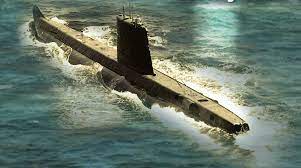Ali Basit
Submarines have always been recognized as a key factor in maintaining a powerful military. Historically it has proved impossible for a country to keep global military status without dominance at sea. Since World War I, it has also been impossible for surface ships to hold dominance at sea without the use of submarines.
Even before a conflict arises, a submarines’ ability to deploy military strengths to an area without being detected is strategically invaluable. This cutting edge capability of submarine service was rightly recognized by the leadership of Pakistan Navy (PN) and thus, Pakistan became the first country in the Indian Ocean Region to operate submarine force. PN submarine force started with just a single submarine, commissioned as PNS/M GHAZI, purchased from US, previously known as USS DIABLO. PNS/M GHAZI participated in Rann of Kutch crisis and displayed her full potential in the 1965 war.
Her deployment in 1965 war forestalled Indian naval forces from even leaving their bases. Realizing the value of a submarine force, Pakistan acquired three Daphne-class submarines from France, the heroic PNS/M HANGOR being one of them. During the war of 1971, the submarine force participated, once again, with utmost vigor. This time PNS/M HANGOR came forward to target Indian Navy ships, INS KUKRI and INS KIRPAN. It is important to realize that the HANGOR action did not develop overnight and the events in 1971 were shaping for such actions due to crisis in East Pakistan. As the hostilities broke out, the period of patience reached its climax on the evening of 9th Dec when the enemy came into effective weapon range of HANGOR as it identified two enemy Frigates some distance off “Diu Head”. Action stations were sounded, with all aboard eager to join the battle.
The Commander of the submarine had no illusions about the risks involved in engaging “hunter-killer” Frigates, specially equipped for anti-submarine warfare. In spite of the risks involved, he moved close to the enemy, determined to inscribe the name “HANGOR in the annals of Pakistan’s history. The Commanding Officer of HANGOR closed the two targets at shallow depth with caution, prudence and exercising all professionalism to avoid detection.
The two contacts were appreciated to be two Indian Anti-Submarine Frigates (INS KUKRI and INS KIRPAN) engaged in Search and Attack Unit operations. HANGOR was waiting on the estimated track of the targets and “Action Stations” were, therefore, sounded that the “shark” had bared its teeth and its moment of reality had arrived. Although the enemy was operating sonar, HANGOR was not detected and therefore, still enjoyed the element of surprise.
The conditions were not favorable for conducive submarine operations due to shallow depth (60-65 meters) in the area and the enemy surface fleet was in advantageous position due to limited maneuverability of submarine. HANGOR was ready and at 1957 hours on 9th of December 1971, the sharp command “Shoot” rang out and the first torpedo sped away.
The torpedo was supposed to hit INS KIRPAN but passed under and did not explode. The element of surprise was lost as the enemy’s warship crew suddenly woke up realizing that they were under attack. The advantage had now shifted completely in favor of the enemy and INS KUKRI homed onto the known direction of torpedo launch position.
The HANGOR crew kept their cool and calmly shifted target to INS KUKRI, obtained a quick solution and fired the second torpedo at it. The torpedo exploded under the magazine of INS KHUKRI and the huge explosion broke the ship into two pieces. With Squadron Commander, Captain Mohindera Nath Mulla onboard KHUKRI went down forever to the bottom of sea.
Having achieved her spectacular success, “HANGOR” started evasive manoeuvres as the enemy was certainly going to react with the entire available resources. For the next three days, Indian warships combed the vicinity of the scene of action and HANGOR was subjected to extensive depth charge attacks. Someone in the crew kept the count and according to him it came to be 156 attacks during this period. An extensive air search combined with surface ships was conducted but with intelligent evasive action, the submarine managed to evade these attacks and arrived in Karachi safely after the ceasefire. Despite these potential hazards, the morale of men onboard HANGOR never wilted. As a member of the crew put it, “The crew always felt that death would not matter so long as they succeeded in destroying the enemy”.
The ship’s crew was justifiably satisfied with their achievement under difficult conditions. For their act of courage and devotion to duty the officers and men of HANGOR were decorated with 06 x Sitara-e-Jurat, 07 x Tamgha-e-Jurat and 21 x Imtazi Sanads. This is the highest number of operational gallantry awards given to a single unit of Pakistan Navy. In order to pay tribute to high level professional crew of HANGOR and their victorious and valour act, 9th December is celebrated as HANGOR DAY each year. On 02 Jan 2006, HANGOR was converted to serve as a museum ship at Pakistan Maritime Museum as a symbol of courage and victory.







